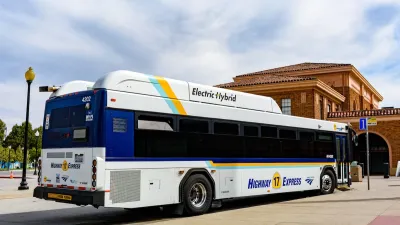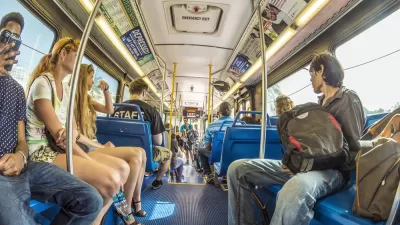In August, I moved into a high density apartment complex just 1.5 miles from my office and a five minute walk to a bus stop. One of the central advantages of the building's location was its access to alternative transportation modes. While I could park my car for "free" (the real cost is built into the lease), I was interested in keeping it parked as much as possible. Now, after nearly three months of experimentation, I'm ready to give up the bus, and the reasons are central to understanding the future of transit in the US.
In August, I moved into a high density apartment complex just 1.5 miles from my office and a five minute walk to a bus stop. One of the central advantages of the building's location was its access to alternative transportation modes. While I could park my car for "free" (the real cost is built into the lease), I was interested in keeping it parked as much as possible. Now, after nearly three months of experimentation, I'm ready to give up the bus, and the reasons are central to understanding the future of transit in the US.
First, I should note that as a bus rider and cyclist, I am in a distinct minority despite living in the middle of a corridor populated by tens of thousands of college and university students. (Tallahassee has a college/university student population of 75,000, or about 23% of the metropolitan area population.) I rarely have to compete for boarding the bus or stand when riding because the buses are crowded.
I'm also usually the only cyclist on the mile stretch of main road heading to campus. (I will occasionally pass someone going in the opposite direction.)
Second, the most efficient and effective way to get to my office on the Florida State campus is by bicycle. I can get reliably door-to-door in under 20 minutes (including the time it takes to lock my bike into the bike rack). This is largely due to Florida State's investment in pedestrian and cycling friendly walkways and underpasses. (Cyclists also share the sidewalks with pedestrians, but that will be the topic of a future post.) Driving is almost as reliable as cycling, but inefficient traffic signal timing and coordination usually extends a 20 minute door-to-door commute to 30 minutes.
So, what about the bus? If the bus is running on time and on schedule, my door-to-door commute can be about 20 minutes. But, that's the problem. The bus is rarely on-time or on-schedule. The buses run on 20-minute headways, so the consequences of missing the bus can be pretty severe for anyone trying to make class or a meeting. I have to arrive at least 5 minutes before the bus is scheduled to arrive in the morning because it often arrives about 5 minutes ahead of schedule. In the afternoons on the return trip, buses have completely missed the stop (and I'm not sure where they've gone). Within the last week, I've walked home after waiting 45 minutes for a bus, and in another case I was left at the bus stop for 40 minutes. So, in order to adjust for the uncertainties of bus travel, I typically have to arrive at the bus stop 10 minutes before the bus arrives in the morning, and I have to plan for waiting 15 minutes to 40 minutes in the afternoon for the return trip.
Thus, as a practical matter, the bus is an option only if I have a lot of time on my hands, have no deadlines, and really don't care what time I get home. It's no wonder that students shy away from taking the bus and, instead, prefer to drive.
All this is anecdotal evidence of what many transit operators already know: Providing high quality, reliable service is essential for transit to survive (not just remain competitive with other modes). With the level of uncertainty and unreliability I experience on a regular basis, I simply can't afford the risk of taking the bus on most days. In my case, I will continue to opt for the bike as long as I live close to campus. On the days when the weather is poor, it's hot, or it's cold, I'll grudgingly pull out the keys to the car and drive the short distance to work. Even though the bus service is free for FSU students, staff, and faculty, the bus is simply too expensive along the dimensions of everday life that count.

Manufactured Crisis: Losing the Nation’s Largest Source of Unsubsidized Affordable Housing
Manufactured housing communities have long been an affordable housing option for millions of people living in the U.S., but that affordability is disappearing rapidly. How did we get here?

Americans May Be Stuck — But Why?
Americans are moving a lot less than they once did, and that is a problem. While Yoni Applebaum, in his highly-publicized article Stuck, gets the reasons badly wrong, it's still important to ask: why are we moving so much less than before?

Research Shows More Roads = More Driving
A national study shows, once again, that increasing road supply induces additional vehicle travel, particularly over the long run.

Judge Halts Enforcement of Anti-Homeless Laws in Grants Pass
The Oregon city will be barred from enforcing two ordinances that prosecute unhoused residents until it increases capacity and accessibility at designated camping sites.

Advancing Sustainability in Los Angeles County Schools
The Los Angeles County Office of Education’s Green Schools Symposium brings together educators, students, and experts to advance sustainability in schools through innovative design, climate resilience strategies, and collaborative learning.

Using Old Oil and Gas Wells for Green Energy Storage
Penn State researchers have found that repurposing abandoned oil and gas wells for geothermal-assisted compressed-air energy storage can boost efficiency, reduce environmental risks, and support clean energy and job transitions.
Urban Design for Planners 1: Software Tools
This six-course series explores essential urban design concepts using open source software and equips planners with the tools they need to participate fully in the urban design process.
Planning for Universal Design
Learn the tools for implementing Universal Design in planning regulations.
City of Moreno Valley
Institute for Housing and Urban Development Studies (IHS)
City of Grandview
Harvard GSD Executive Education
NYU Wagner Graduate School of Public Service
City of Cambridge, Maryland
Newport County Development Council: Connect Greater Newport





























